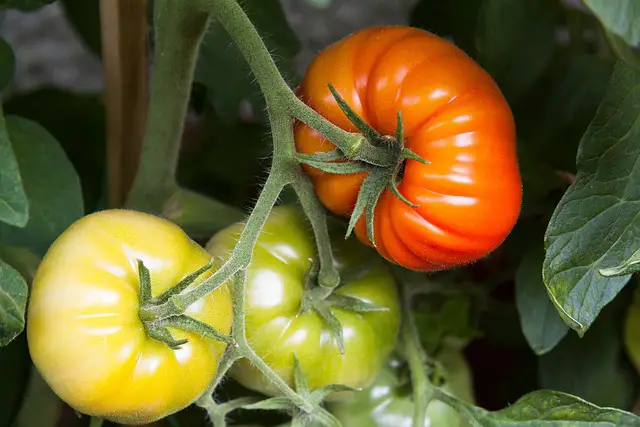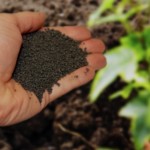Determinate tomatoes are a type of tomato plant that grows to a predetermined size and stops growing once it reaches that point. These tomatoes are often referred to as “bush” tomatoes because they have a more compact and bush-like growth habit.
Key characteristics of determinate tomatoes include:
- Compact Size: Determinate tomato plants are relatively small and don’t continue to grow indefinitely. They typically reach a specific height, usually around 2 to 3 feet (60 to 90 centimeters).
- Fruit Setting: Determinate tomatoes tend to set and ripen their fruit over a relatively short period, usually a few weeks. This can be advantageous for gardeners who want a more concentrated harvest.
- Ideal for Containers: Due to their compact size, determinate tomatoes are well-suited for container gardening or small garden spaces where vertical space is limited.
- Harvesting Time: Since determinate tomatoes set fruit and ripen within a specific time frame, they are often preferred by those who want a more predictable and synchronized harvest.
Why Prune Determinate Tomatoes?
Improved Air Circulation
Pruning helps create better air circulation around the plant. This is vital for preventing the development of fungal diseases, as good airflow reduces humidity around the leaves.
Disease Prevention
By removing lower foliage and any diseased branches, you significantly reduce the risk of common tomato diseases. Pruning acts as a preventive measure, promoting overall plant health.
Enhanced Fruit Quality
Pruned determinate tomatoes often produce larger and healthier fruits. The concentration of nutrients in fewer fruits results in a more robust flavor and better texture.
When to Prune Determinate Tomatoes
Timing is crucial when it comes to pruning determinate tomatoes. Aim to start pruning when the plant has reached a certain height, typically after the first set of flowers appear. Identify the optimal growth stage to ensure maximum benefit.
Step-by-Step Guide to Pruning Determinate Tomatoes
Pruning determinate tomatoes is a straightforward process that involves removing specific parts of the plant to promote better air circulation, sunlight penetration, and overall fruit production. Here’s a step-by-step guide to pruning determinate tomatoes:
Materials Needed:
- Clean, sharp pruning shears or scissors
Steps:
- Wait for the Right Time:
- Pruning is typically done when the plant is established and has a few sets of true leaves. Avoid pruning seedlings or very young plants.
- Aim to prune when the plant is dry to reduce the risk of disease transmission.
- Identify Suckers:
- Suckers are the small shoots that grow in the crotch between the main stem and branches. In determinate tomatoes, these suckers are the side shoots that can be pruned.
- Locate the Main Stem:
- Identify the main stem, which is the central, vertical part of the plant. This is where most of the fruit and flowers develop.
- Remove Suckers:
- Using your pruning shears or scissors, carefully pinch or cut off the suckers. Start with the lower suckers and work your way up.
- Pinch or cut the suckers close to the main stem to prevent regrowth.
- Prune Diseased or Yellowing Leaves:
- Inspect the plant for any yellowing or diseased leaves. Remove these leaves by cutting them off at their base.
- Discard the pruned material away from the garden to minimize the risk of spreading diseases.
- Maintain a Central Leader:
- Keep the main stem (central leader) intact and avoid pruning it. This helps the plant maintain a more compact and structured growth.
- Remove Excess Foliage:
- If the plant becomes too dense, selectively remove some excess foliage to improve air circulation and light penetration. This can be particularly important for preventing diseases.
- Stake or Support the Plant:
- If your determinate tomato variety tends to produce heavy fruit clusters, consider providing support with stakes or cages to prevent branches from breaking.
- Continue Monitoring:
- Regularly check your determinate tomatoes for new suckers and additional pruning needs as the plant continues to grow.
By following these steps, you can help your determinate tomatoes grow more efficiently, produce healthier fruit, and reduce the risk of diseases. Keep in mind that while pruning can be beneficial, over-pruning should be avoided to ensure the plant’s overall productivity.
Common Mistakes to Avoid
Over-Pruning
While pruning is beneficial, excessive pruning can harm the plant. Avoid removing too much foliage, as this can lead to sunscald and reduced fruit production.
Neglecting Proper Tool Care
Regularly clean and sharpen your pruning tools. Neglecting this can introduce pathogens to the plant, hindering its growth.
Benefits of Pruning for Fruit Production
Larger and Healthier Tomatoes
The concentration of nutrients to fewer fruits results in larger and healthier tomatoes. This is particularly appealing for those looking to maximize their harvest.
Consistent Ripening
Pruning helps ensure that the tomatoes receive ample sunlight, leading to consistent ripening. This makes harvesting more manageable and allows for a steady supply of ripe tomatoes.
Tips for Pruning Success
Regular Monitoring
Frequent checks on your tomato plants enable you to identify issues early on. Adjust your pruning strategy based on the plant’s response to maximize benefits.
Adjusting Based on Plant Response
Every plant is unique. Pay attention to how your determinate tomatoes respond to pruning and adjust your approach accordingly.
Alternative Pruning Methods
Single Stem Pruning
Some gardeners opt for a single-stem pruning method, focusing on one main stem for optimal fruit production. This technique is particularly useful for determinate tomatoes.
Florida Weave Technique
This alternative method involves supporting the tomato plants using a weaving pattern with twine. It provides stability and encourages an organized growth structure.
FAQs
- Q: How often should I prune determinate tomatoes?
- A: Prune determinate tomatoes regularly, focusing on removing suckers and lower foliage every two weeks during the growing season.
- Q: Can I use regular household scissors for pruning?
- A: While not ideal, you can use household scissors for light pruning. However, investing in proper pruning shears is recommended for better results.
- Q: Will pruning determinate tomatoes affect overall yield?
- A: Proper pruning enhances overall yield by directing the plant’s energy to fewer, but larger and healthier, fruits.
- Q: What is the best time of day to prune tomatoes?
- A: Opt for early morning or late afternoon to prune tomatoes, avoiding the hottest part of the day to minimize stress on the plants.
- Q: Can I use the pruned foliage for composting?
- A: Yes, pruned foliage can be added to compost bins, contributing to nutrient-rich compost for your garden.
Conclusion
So there you have it – the simple art of pruning determinate tomatoes. By giving your plants a little care, you’re not just preventing diseases and boosting fruit quality, but you’re creating a path to a tomato harvest that’s nothing short of fantastic. So, grab those pruning shears, enjoy the process, and get ready to savor the delicious rewards of your well-tended determinate tomato garden.






